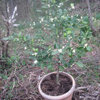Two springs ago I pollenated my 'Temple' orange with poncirus 'Flying Dragon' pollen of which 15 fruits were produced. These 15 fruits all made seeds sprouting hybrid seedlings which amounted to around 250.
My report today is about one of two unusual monofoliate yet truely hybrid seedlings. Both monofoliate hybrid seedlings came from the same fruit which is interesting in itself.
Both monofoliate seedlings were grown to 5 gallon size in the greenhouse and planted last summer, in pot, in the open field, exposed to all winter weather. Early December gave these two plants a early and harsh cold hardiness test with two nights of lower single digits and several daytime highs of upper teens to lower 20's. New Year's day I removed the monofoliate hybrids from their outdoor setting and place inside the warm greenhouse for a early spring.
One monofoliate seedling froze to near ground level but the other survived in fair shape. The monofoliate survivor did not go untouched but in my opinion showed good potential hardiness with only 30% younger stem damage in the upper canopy. What is so great about it's winter hardiness is the lower trunk did not have any air/soil transition zone damage. I have found those lower trunk freeze cracks the most deadly to hybrid citrus. December's frigid cold is the worst for those air/soil transition zone freeze cracks because the still warm soil seem's to keep sap flowing near ground level.
This now cold proven and worthy of further development hybrid has very sweet smelling leaves that are often monofoliate but sometimes will produce a trifoliate. Often a monofoliate leaf will have almost no petiole but the few trifoliate leaves will always have a regular petiole. The monofoliate leaves seem to have a very rough texture and sawtooth margin where the few trifoliate leaves will be smoother in texture and margin. The monofoliate hybrid's growth form is more branched than typical and rate of growth slightly slower than typical, yet robust. I hope the early branching growth form will mature into a fruiting stage faster than normal so I can get that all important taste test. I'll be budding some juvenile wood from 'monofoliate' within the upper canopy of a fruiting citrumelo, trying to forced mono into maturing.
That's all for now and here are some pics of the new growth. A very interesting atypical hybrid since it has cold hardiness.
Notice the Red Mite. My worse citrus pest.
{{gwi:576193}}
{{gwi:576195}}










citrange2
gonebananas_gw
Related Professionals
Simpsonville Landscape Architects & Landscape Designers · South Orange Landscape Architects & Landscape Designers · West Chester Landscape Architects & Landscape Designers · Elgin Landscape Contractors · Gainesville Landscape Contractors · Milford Landscape Contractors · Springfield Landscape Contractors · Alpharetta Landscape Contractors · Blue Springs Landscape Contractors · Columbine Landscape Contractors · Merced Landscape Contractors · Middletown Landscape Contractors · Seminole Landscape Contractors · Teaneck Landscape Contractors · Reisterstown Landscape ContractorsDon_OKCOriginal Author
paty99